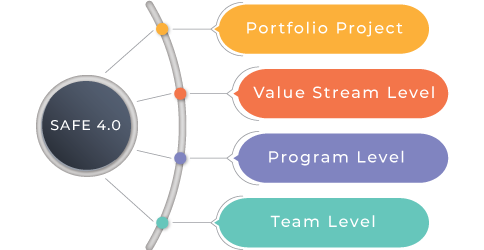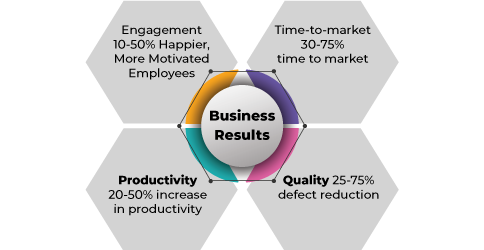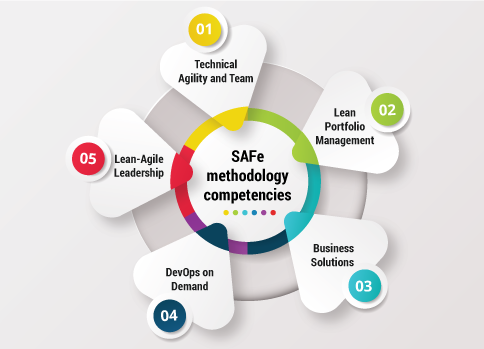
The agile approach has made it easy to handle projects efficiently. It is an iterative approach for project management and software development, which also helps to save cost, time, and resources. It delivers better value to the customers by releasing software in small increments.
Many larger organizations are not suited to get the benefits of Agile development. In this relate, Scaled Agile Framework (SAFe®) is a fine-tuned tool to help larger enterprises to overcome the issue that negatively impacts project success. This framework is widely known as the SAFe methodology.
Let’s take an overview of SAFe principles, competencies, and how to implement its methodologies.
SAFe Methodology – Definition
Scaled Agile framework encompasses workflows, organizational patterns, principles, and best practices to implement agile methodologies for larger organizations. The SAFe framework structure comprises the body of knowledge encompassing roles and responsibilities, handling work, and using appropriate values.
The SAFe methodology is ideal for large teams handling complex projects at various levels, such as program, portfolio, and project levels. The structured and systematic approach to SAFe drives its popularity.
According to the 12th Annual State of Agile Report,” The Scaled Agile Framework(SAFe) is reported as the most widely-used approach to scaling agile with nearly 1/3rd (29%) saying that SAFe is the method they need to follow closely”.
SAFe Methodology Competencies
SAFe methodology mainly focuses on five competencies that help organizations respond to changing market conditions, customer requirements, and emerging technologies:
Lean-Agile Leadership
Agile leaders can influence the individuals and the team in accomplishing their goals and support organizational change and its efficiency.
Technical Agility and Team
The agile team should possess essential skills and adhere to the Lean-Agile principle to develop quick solutions. Meanwhile, the team’s technical knowledge is equally necessary as they are accountable for the final work delivered to the customers.
Lean Portfolio Management
To successfully implement the SAFe methodology, it’s essential to have a profound organizational strategy considering various aspects such as compliance management, portfolio management, and financial considerations.
Business Solutions
Organizations facilitate Lean-Agile Practices to drive the entire project blueprint, development, and deployment.
DevOps on Demand
The development of continuous and ongoing pipeline delivery for deliverables is essential for value creation to the customer requirements.
Why Use SAFe Methodology?
The SAFe methodology is used by organizations globally for the following proven reasons:
- It increases quality and productivity
- Increases the staff involved in product delivery
- Provides faster time to market
Here are a few situations that explain to you when to use the SAFe methodology:
- When the team wants to work independently and implement an agile approach across various team programs and portfolios.
- The team faces delays, failures, and obstacles while implementing agile.
- When the team wants to scale agile across the enterprise but is unsure of the new roles to be created, what changes have to be made for the existing roles, and how the changes should look.
- To enhance the organization’s product development strategies.
- When trying to scale agile across the organization but facing issues relating to achieving consistent and uniform strategy across various departments.
Various Levels in SAFe Methodology

Team Level
All the SAFe teams are part of the Agile Release Train(ART). They are cross-functional, self-managing, self-organizing, and responsible for defining and developing the teams. This is quite similar to any Scrum team.
The team level contains events, roles, and processes and provides the Agile Release Train(ART). The development time is usually divided into a set of iterations called Program Increments(PI) with 8-12 weeks.
Program Level
The program level in SAFe works similarly to the team level and includes different teams working under the program management team. The level includes roles, activities, and artifacts to deliver solutions through the Agile Release Train(ART). This level comprises stakeholders, development teams, and other resources required for the development process. The ART group comprises 5-12 teams and works together considering a time-boxed approach wherein the product increments are 8-12 weeks.
Portfolio Level
The portfolio level is the highest level of concern in SAFe. This level provides practices, roles, and principles required to initiate the set of development streams and assists in developing solutions and systems in creating strategic themes.
The portfolio level delivers the essential foundation for developing the Lean-Agile Enterprise around the value flow, considering two or more value streams. It provides basic budget, and governance mechanisms and ensures that value streams and ART focus on developing appropriate things with suitable investment levels.
Value Stream Level
Value Stream Level is an optional level that mainly targets large solutions, requires multiple ARTs, and provides various new features.
This level’s main purpose is to explain the Lean-Agile approaches to define, develop, and implement critical solutions which further help you deal with the challenges during the process. Solution failure usually leads to undesirable social and economic consequences.
Value Stream level usually revolves around program increments and coordinating through Agile Train Release(ART). To discuss the project’s progress and plan things accordingly, this level also comprises pre and post Program Increment planning meetings and solution demos. The level provides various job roles such as value stream engineer, solution engineering, and solution management.
SAFe Methodology Configurations for Organization Agility
SAFe supports a wide range of development environments with four different configurations. You need to make the apt choice, of which SAFe configuration you need to use for organizational agility.
The four configurations are as mentioned below:
Essential SAFe
Essential SAFe is the basic building block of other SAFe configurations. This phase comprises all the essential elements required for the SAFe framework’s benefit and starting point for implementation. It provides complex solutions for large teams. The level comprises a program and team levels.
Portfolio SAFe
Portfolio SAFe is mainly for the enterprises to align agile development into value streams and ARTs. The concept of Lean-Agile budgeting provides permission to the decision-makers and includes portfolio visibility and WIP limits through the Kanban system. And the objective metrics support governance and improvement. This configuration level comprises of Portfolio level, Program level, and Team level.
Large Scale SAFe
Large Scale SAFe configuration provides complex solutions that don’t need portfolio management assistance. It is widely used in the defense, automotive, and aerospace industries. This is used primarily for organizations that don’t need a portfolio of projects. It requires large teams to deliver the project within the given duration.
Full SAFe
Full SAFe is a comprehensive SAFe framework comprising all the SAFe levels- Team level, Value Stream level, Portfolio level, and Program level. Organizations widely use this to get the complex solution to deliver the product.
To sum it up, Full SAFe is a set of best practices that can be used by the teams to deliver products, each having its pros and cons.
Integrate SAFe with Agile certification courses and gain excellence in Agile!
SAFe Methodology Principles
The SAFe methodology is based on existing Agile and Lean principles: Here are a few principles of SAFe that form the base/bedrock:
- Use the SAFe framework to implement the systems considering all the aspects of development.
- Distribute the decision-making process to the teams, which in turn helps them to become more agile.
- Set milestones considering object estimation and evaluating the working systems ensuring an economical benefit.
- To enable continuous workflow, decrease the batch size, limit the work in progress, and manage the queue length.
- Build a product using an incrementally fast approach, milestones, integrated learning cycles, incorporate customer feedback and reduce risks.
- Take an economic view of the project, thereby providing optimal lead time for the team and product development flow.
SAFe Certification and Training
Invensis Learning provides SAFe for a team training course that teaches you the best practices and principles of this methodology. Having accredited SAFe qualifications is beneficial for aspiring professionals looking for an Agile Coach or Agile team leader’s job role.
The list below covers some of the SAFe certifications provided by Invensis Learning accredited by Scaled Agile:
- SAFe Scrum Master
- Leading SAFe
- SAFe for Government
The rise in the demand for the Agile framework paves the way for professionals for the foreseeable future. If you are looking out for a secured career with decent earnings, consider becoming an agile coach. Invensis learning helps you to give a kick start to your career.


















